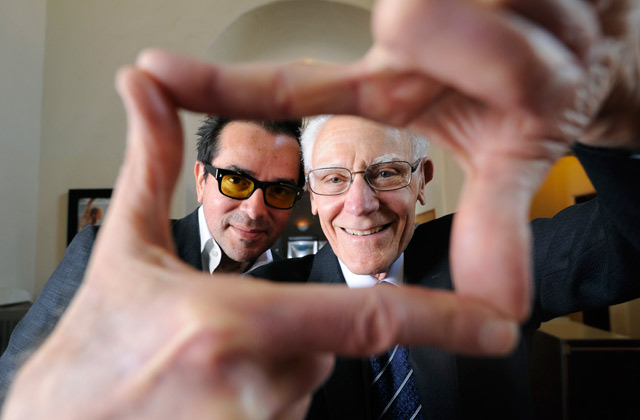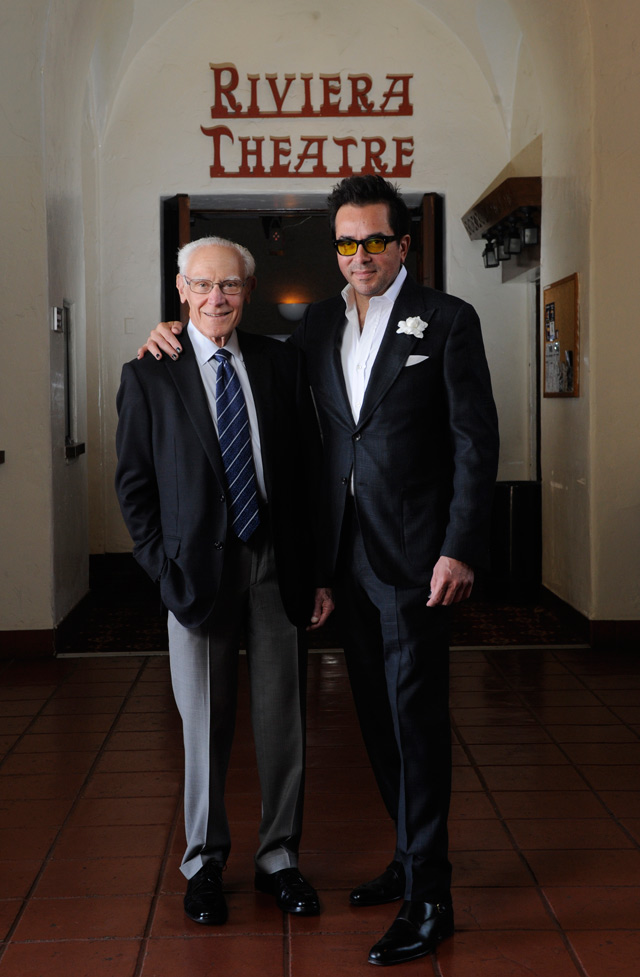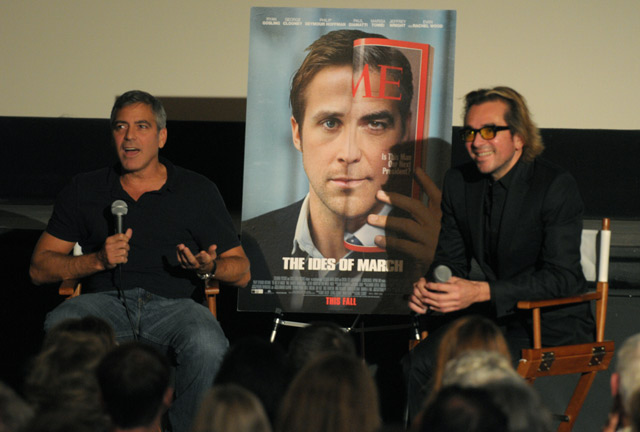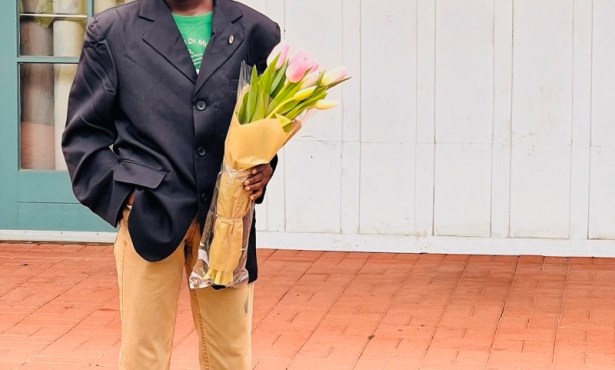Film Fest’s Riviera Dream Comes True
SBIFF to Take Over the Historic Theater for Next 30 Years

When Roger Durling moved to Santa Barbara almost 20 years ago, long before he took the reins as creative director of the Santa Barbara International Film Festival, he quickly found solace in the Riviera Theatre. “It was a sanctuary for independent cinema,” said Durling of his first impressions of the theater, which is the centerpiece of a hillside, century-old office park just off Alameda Padre Serra that served as the first campus for both UCSB and SBCC. “And there’s something amazing about stepping out of a movie house and looking out to see the Channel Islands and the Arlington and all of downtown Santa Barbara from up there. It’s a pretty special view.”
Last Thursday, Durling and the film fest’s board officially became the conservators and curators of this cinematic sanctuary by signing a lease that effectively puts them in control of the Riviera Theatre for the next 30 years. The bold move puts an exclamation point on SBIFF’s evolution during the past decade from merely a 10-day festival into a truly year-round institution that showcases indie/foreign films every Wednesday, hosts celebrity interviews and prerelease screenings most weekends, throws two annual mini-fests, and is steadily expanding educational and free film opportunities for all ages and income levels.
“It’s a major turning point for the film festival,” said Durling. “It will crystallize the expansion of all the different programs we have. Ultimately, it will definitely grow our stature and importance culturally, not just in the city, but I’m certain on a national and international level.”
The Towbes Touch
In the works for nearly two years, the deal was specially crafted with property owner Michael Towbes, the developer whose philanthropic support for Santa Barbara’s artistic and cultural communities is unparalleled. “I was around when the film festival started, and to see the way it’s grown over the years — it’s quite impressive,” said Towbes. “It’s really helped put Santa Barbara on the map.”
Still, he was a little confused when SBIFF expressed interest in managing the Riviera as a year-round venue. “I had no idea that they had plans to expand their programming as much as they do,” said Towbes. But he was still reluctant because, for the past 27 years, the Riviera Theatre has been leased by the Metropolitan Theatres Corporation (MTC), the family-owned company that controls every other movie house in town. “We are very fond of the Metropolitan Theatre folks, and they’ve done a good job there, so it was not an easy decision,” said Towbes. “But I thought that being able to expand the activities of the film fest would be good for the community.”

The SBIFF team working the deal — which included president Mark Scher, CFO Bob Brada, Eric Phillips, and Jeff Barbakow — also realized the potential political implications of taking over the lease, since they rent many State Street theaters from MTC during the January-February festival, an important concern considering SBIFF plans to always hold the extremely popular festival downtown. Luckily, their relationship with the Corwin family, which owns MTC, remains strong — in fact, MTC will likely continue running the Riviera’s day-to-day operations, though those details are still being worked out. “There was concern, of course, but they’ve [MTC and the Corwin family] been more than cooperative and are excited for us,” said Scher. “We will continue to work together and even deepen the relationship.”
David Corwin, president of MTC, confirms as much, though he said there are plenty of logistics left to untangle, from equipment to licensing issues. “It’s a little bit of a role reversal,” said Corwin. “But at the end of the day, the theater will get improved, and we will provide that much more programming for the community. It should be a win-win for everyone.”
As part of the lease — which is for 20 years with a 10-year option, though financial details have not yet been disclosed — Towbes is taking responsibility for infrastructure upgrades, such as the bathrooms, while SBIFF will raise an undetermined amount of money to fund improvements to the theater itself, from the seats and air conditioning to the sound system and screen projection. Towbes’s infrastructure work should start this summer (and the theater should remain open, though with porta-potties). SBIFF plans to start adding its touches in January 2017 when the film fest season is in full swing.
The theatrical improvements should take between six weeks and two months, and they’re long overdue, as complaints about the theater’s uncomfortable seating, stale air, and less-than-ideal movie-watching experience are common. “People are fine going into the theater in its historical condition,” said Brada, “but they’re gonna be really happy going in a year and a half from now.”
Cinema Society Surging
It’s not often that a nonprofit arts organization leaps into the brick-and-mortar role of managing a venue, but Durling, who took leadership of the festival in 2002, explained that the idea of bringing everything under one roof has been on SBIFF’s collective mind for quite some time. “The recession slowed down a lot of these long-term plans that we had,” he said. “It wasn’t until a few years ago where we were financially in a good place to start fulfilling the idea of doing The Wave Film Festivals, to start doing Showcase screenings, and to expand the Cinema Society.” [See the below “What Does SBIFF Do?” for more info on those.]

The latter’s growth to 500 members and dozens of films annually under Durling’s tenure is what prompted the move from downtown smaller theaters to the 400-seat Riviera more than a decade ago. The major draw is the celebrity factor, as Durling successfully attracts top directors, actors, and other talent to do Q&As in the theater after screening their new films, 33 of which showed last year. While a film festival taking over a venue is not entirely unheard of — the Seattle and Denver fests operate their own year-round venues, for instance — Durling explained, “The one thing that is extremely unique is the presence of the talent pool that attends the Cinema Society.” When he tells his friends who attend the renowned Lincoln Center film series in New York that he just screened Room and spoke to Brie Larson or did Concussion and interviewed Will Smith, they’re floored.
It’s certainly a chicken-and-egg situation, but Durling blames the intelligence of the Santa Barbara film audience for his ability to pull major names. “We hear it over and over again from the talent that comes,” he said. “They want to come to Santa Barbara not just because of how alluring and enticing the place is but also because it’s a very sophisticated audience.”
SBIFF further fosters that sophistication into the younger generations through various outreach and educational programs, from the free AppleBox screenings for all ages to Mike’s Field Trip to the Movies, where kids from around the county’s schools, particularly those from lower-income areas, come to see a film and listen to a director talk. Both of those have traditionally happened only during the festival, but the plan is to offer them more regularly at the Riviera. SBIFF is also hosting a film camp this summer in conjunction with the Boys & Girls Club and kicking off the Rosebud Program, in which 30 college students from the Santa Barbara area will attend Cinema Society screenings and complete curriculum around them.
Much of this is done to honor the spirit of Mike DeGruy, the nature filmmaker and longtime SBIFF supporter who died in a 2012 helicopter crash while working. “He’s been a driving force and inspiration for all the programming,” said Durling, who keeps a photograph of DeGruy on his desk. “Now he would be very proud.”
Risk vs. Reward
Inspiration aside, even very successful nonprofits must constantly assess financial risk, which becomes especially acute when jumping into commercial real estate investments. That’s where Brada, formerly general counsel for MGM, and Scher, a commercial real estate developer and investor, came in. “We’re very expert-heavy on the board on how to deal with long-term leases,” said Brada, who explained that the organization is very sound financially and that plenty of numbers were crunched before diving into the lease, including how much rent they’re already paying to show weekly films. “It starts getting to where it’s a seriously limited financial risk in return for what I think strategically is a huge benefit.”
Scher admits that this is not meant to be a profitable venture and that lots of fundraising will be required, but that’s all been taken into account. “We have a five-year strategic plan that we’re executing on, and this is a big part of that plan,” said Scher. “The board has been very deliberate in making sure that we cannot only handle this lease, but that it will spur our growth.”
Towbes, meanwhile, believes that one of his favorite properties remains in very good hands. “It’s been a labor of love for me,” said Towbes of the Riviera complex, which he’s improved even when it doesn’t make economic sense. “I’m very fond of it, and it has such history, going back more than 100 years now. I’ve treated it as a very special property.”
Presumably, thanks to the SBIFF outreach, even more Santa Barbarans will come to love it, as well. “There is such a voracious appetite in this town for independent cinema and foreign cinema and documentaries, and to be able to fulfill that necessity is terrific,” said Durling. “And to have a place where we can do Field Trip to the Movies all year and to do AppleBox so low-income families can attend for free — all of these different things that the festival does will be maximized. And that is hugely rewarding to know.”

What Else Does SBIFF Do?
Everyone knows about the Santa Barbara International Film Festival itself, the 10-day cinematic extravaganza that takes over downtown every winter (next installment: February 1-11, 2017), but not so many know about what SBIFF does year-round. Here’s a sampling:
The Wave: Two annual five-day festivals focused on films from specific parts of the world. This year’s offerings are Pan-Asia (May 11-15) and France (July 13-17). All screenings are at the Riviera.
Cinema Society: Members pay $600-$3,000 annually to attend screenings almost every week at the Riviera, with an increasing frequency in the fall. They’re usually followed by a Q&A with one of the film’s stars in front of or behind the camera. The Rosebud scholarship allows 30 college students from around the Santa Barbara area to attend, as well.
The Showcase Film Series: Every Wednesday at 5 and 7:30 p.m., for the price of a normal movie, SBIFF shows a foreign or independent film that otherwise would not have hit Santa Barbara screens. They play at Plaza de Oro but will soon move to the Riviera.
See sbiff.org.



